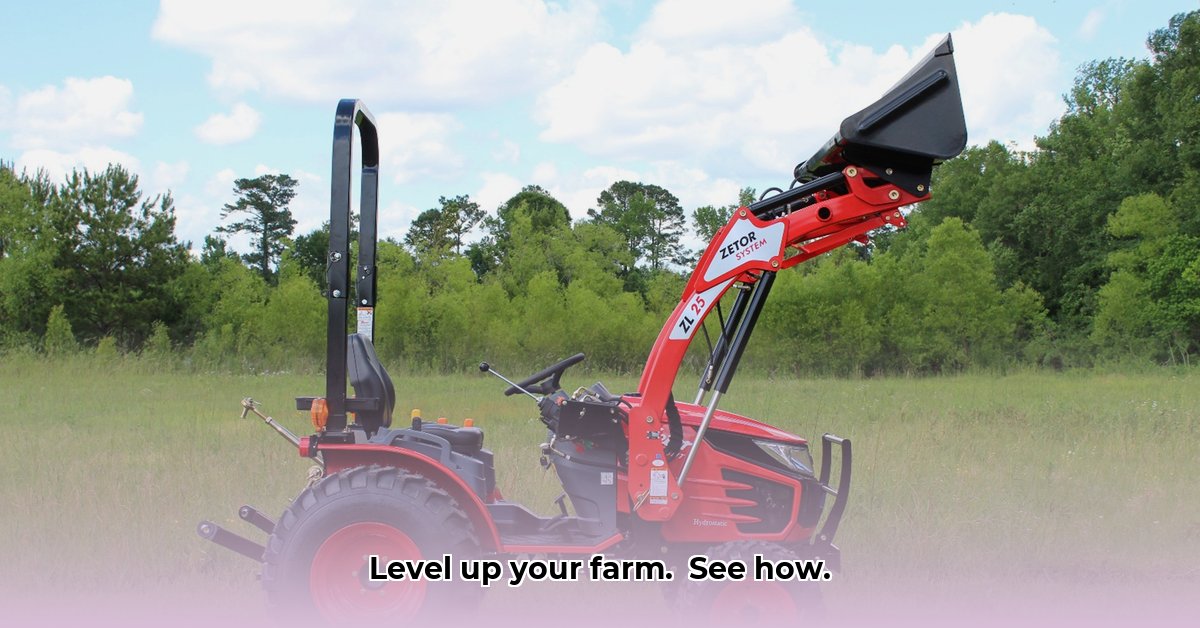
Leveling up your farm game just got easier. Self-leveling small tractor loaders are revolutionizing material handling on farms, offering significant improvements in efficiency and safety. This article explores how these loaders, particularly those from John Deere, can enhance your operations and provides a practical guide to help you decide if this technology is right for your farm. For more information on tractors, check out this helpful resource: 4-wheel drive tractors.
How Self-Leveling Small Tractor Loaders Work
Self-leveling loaders utilize advanced hydraulic systems to keep the bucket perfectly level, automatically compensating for uneven terrain. Unlike traditional loaders, they constantly adjust to maintain a consistent, level position, regardless of the tractor's angle. This eliminates the need for manual adjustments, resulting in smoother, easier loading and unloading, even on hilly or uneven ground. Think of it as a sophisticated balancing act, performed automatically by the machine's hydraulics.
Benefits for Sustainable Farming Practices
The benefits extend beyond simple convenience. Self-leveling loaders significantly boost productivity by speeding up loading and unloading processes. This translates directly into cost savings: less time spent working means lower fuel consumption and reduced labor costs. The consistent level of the bucket also minimizes spillage, conserving valuable resources and reducing waste—a key component of sustainable farming. Furthermore, the enhanced control and reduced operator effort contribute to a safer working environment, minimizing the risk of accidents and worker strain.
Limitations and Considerations: A Realistic Perspective
While the advantages are compelling, some limitations warrant consideration. Currently, comprehensive comparative data between self-leveling and standard loaders is limited. More research is needed to fully assess long-term impacts on soil compaction and fuel efficiency, although early indications suggest potential benefits in both areas. Farmers should also anticipate higher maintenance requirements and a higher initial purchase price compared to traditional loaders.
Actionable Steps for Farmers: Your Investment Guide
Ready to evaluate this technology? This step-by-step guide assists you in determining the suitability of a self-leveling loader for your farm:
Assess Your Needs: Carefully analyze your farm's specific material handling needs (hay, grain, manure, etc.) and volume to determine the appropriate loader size and features. Consider the types and amounts of materials you handle daily or seasonally.
Develop a Comprehensive Budget: Obtain quotes from multiple dealers and factor in operational costs (fuel, maintenance, repairs). Conduct a thorough return on investment (ROI) analysis, comparing potential savings in labor and fuel against the higher upfront investment.
Conduct a Hands-On Evaluation: Request a demonstration on your farm's terrain. A hands-on experience is crucial to determine the loader's suitability for your specific conditions and operational requirements.
Thoroughly Research Maintenance and Support: Investigate maintenance schedules, associated costs, warranty coverage, parts availability, and the typical lifespan of critical components. Plan for potentially higher maintenance costs compared to standard loaders.
Future Research and Development: The Path Forward
Despite the advancements, further research is necessary. Independent comparative studies are required to provide definitive data on fuel efficiency and soil compaction across diverse applications and soil types. Continuous research will further refine our understanding of this technology's benefits and limitations, ensuring its responsible integration into sustainable agricultural practices.
Weighing the Pros and Cons: An Informed Decision
To assist your decision-making process, consider this summary:
| Advantages | Disadvantages |
|---|---|
| Increased productivity | Higher initial purchase price |
| Improved efficiency and reduced waste | Requires further research for long-term impacts |
| Enhanced operator safety and comfort | Potentially higher maintenance requirements |
| Potential fuel savings (needs further research) | Limited comparative data currently available |
Managing Risks: A Proactive Approach
A proactive risk assessment is crucial before investment:
| Feature | Risk Category | Likelihood | Severity | Mitigation |
|---|---|---|---|---|
| Self-Leveling Hydraulic System | Mechanical Malfunction | Moderate | High | Regular maintenance, comprehensive warranty |
| Increased Efficiency | Soil Compaction | Low | Moderate | Careful operation, sustainable land management practices |
| Data Limitations | Misinformed Decisions | Moderate | Moderate | Rely on independent data and thorough reviews |
Investing in a self-leveling small tractor loader requires careful consideration. This analysis provides a balanced perspective, highlighting potential benefits while acknowledging areas requiring further investigation. Remember, continuous research and responsible implementation are crucial to maximize this technology's advantages in sustainable agriculture. A thorough cost-benefit analysis tailored to your specific farm operation is essential before making a final decision.